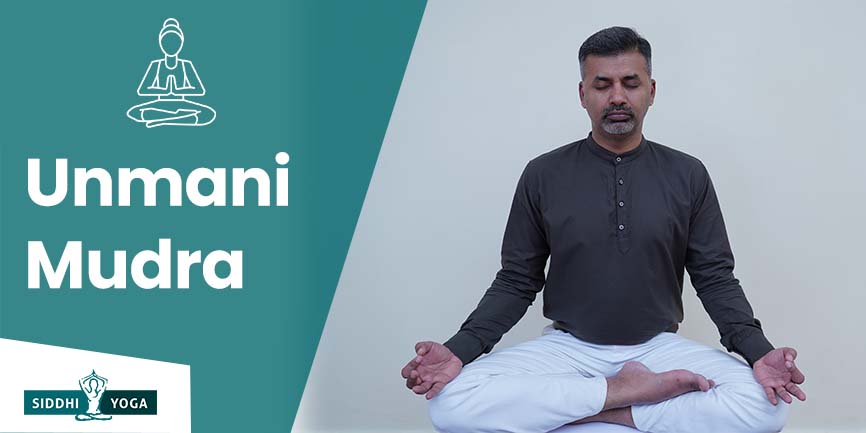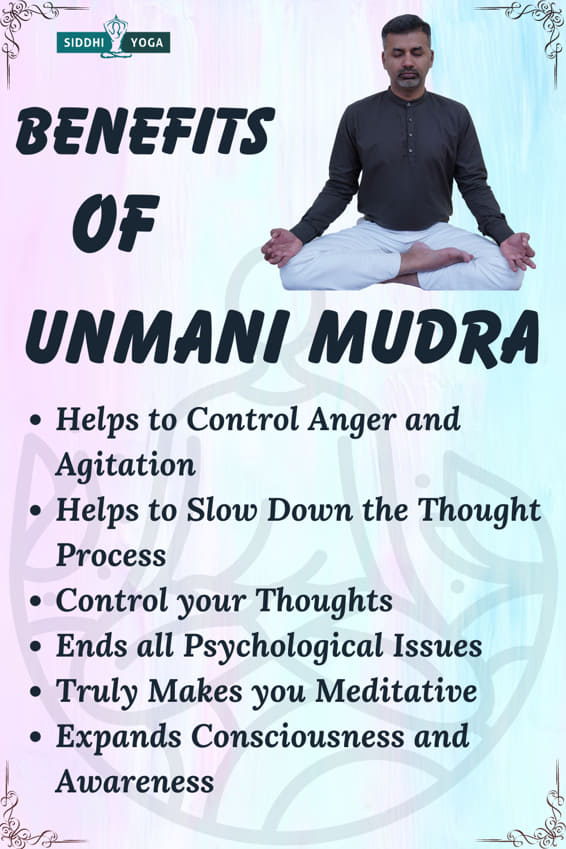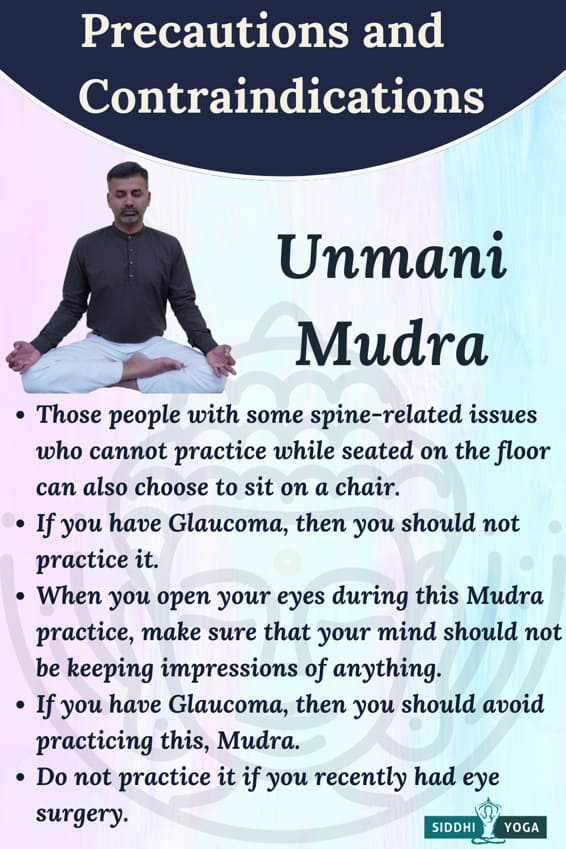
Discover the meaning and benefits of the Unmani Mudra, a sitting meditative mudra that can help you achieve focus and concentration.
Definition – What is Unmani Mudra and its Meaning, References, and Mythology?
Unmani Mudra is one of the Mudras or gestures/seals which is best suited for meditation practices. Let us simplify its meaning to understand it better.
Unmani – The Sanskrit word “Unmani” represents a state where there is a complete state of thoughtlessness, and no thought can penetrate your mind. It is a thoughtless or no-mind state.
Mudra – the Sanskrit word “Mudra,” as we all know, represents a gesture or seal.
So, we can understand that when we practice Unmani Mudra, this brings us to a state where we observe a state of thoughtlessness. We do not engage our minds in any thought or object.
It is similar to a state of mind that is considered the ultimate goal of Yoga practices, especially in Samadhi or liberation. Samadhi, or liberation, is a state where we achieve complete calmness and serenity. The Sanskrit word “Yogah” itself can be translated as Union. Here, you become one with your entire self. When we become one with nature, planet earth is considered the true Union or Yoga. Maharshi Patanjali, one of the greatest sage, who has written the Yoga Sutra, classifies this type of meditation as Anya (the otherwise meditation). According to Maharshi Patanjali, such a form of meditation (Samadhi/Liberation) is supreme among all other meditation techniques.
Virama – Pratyaya – Abhyasa – Purvah – Samskara – Sesah – Anyah |Chapter – 1, Sloka – 18|
When a meditation technique is followed for a long time, and no fluctuations in mind can hinder our Sadhana (Practice), this kind of Samadhi is the other (Anya) kind of Samadhi.
According to various commentaries based on Yoga Sutra, this form of mediation can be called Asampragayat Samadhi.
So, one can say that this Mudra helps us prepare for our Yoga practices’ ultimate goal.
This Mudra serves great value in fighting all sorts of attachments. In Yogic philosophy, attachments are known as a cause of sorrow. Even Bouddhik Philosophies believe the same.
It is a state where your mind is placed in a state somewhere between consciousness and unconsciousness. Hence, we can understand that this Mudra is based on mental rather than physical activities. Therefore, it is also called one of the Mana Mudras (Head Gesture or seal).
Alternate Names of Unmani Mudra
Asampragayat Samadhi, mindlessness mudra.
How to Do Unmani Mudra?
- This Mudra is based mainly based on meditation practice. So, we recommend you start practicing this Mudra by sitting in any seated comfortable meditative posture such as Swastik Asana (Auspicious Pose), Padma Asana (Lotus Pose), or Siddh asana (Accomplish Pose).
- Start to erect your neck and spine comfortably.
- With a deep inhalation, place your palms comfortably on your knees. You can assume Chin Mudra, Dhyana Mudra, etc.
- Now, gently close your eyes and bring awareness to your inner self.
- First, Inhale deeply, then hold your breath and slowly start to bring your awareness towards Bindu, located at the back of your head.
- Now, breathe out and let your awareness descend to the length of your spine from the Ajna Chakra, Vishuddhi Chakra, Anahata Chakra, Manipura Chakra, Swadhisthana Chakra, and finally, the Mooladhara Chakra.
- Keep your eyes closed till you reach the Mooladhara Chakra.
- Your awareness should be situated to the inner self even when the eyes are open.
- With the next inhalation, start with the second round.
- Continue the practice for 10-15 more minutes.
Unmani Mudra Benefits

- This Mudra practice can help you achieve the ultimate goal of Yogic practices, the Asamprajnata samadhi. This can help a soul liberate from the vicious cycle of birth and death.
- This helps to control anger and agitation issues.
- It helps to slow down the thought process, and you experience a sense of calmness that you have never experienced before.
- When you can control your thoughts, you can almost control your mind. This Mudra practice can help you achieve anything you want in your life by maximizing your focus on your goal.
- It ends all psychological issues such as stress, anxiety, and depression.
- This Mudra practice truly makes you meditative.
Unmani Mudra Precautions and Contraindications

Similar to all other Mudra practices, it has no side effects.
However, there are a few things to consider:
- Those people with some spine-related issues who cannot practice while seated on the floor can also choose to sit on a chair.
- If you have Glaucoma, then you should not practice it.
- When you open your eyes during this Mudra practice, make sure that your mind should not be keeping impressions of anything.
- If you have Glaucoma, then you should avoid practicing this, Mudra.
- Do not practice it if you recently had eye surgery.
- You should avoid practicing if you have diabetic retinopathy or similar problems.
When and how long to do Unmani Mudra?
- This Mudra practice is for those who want to break the cycle of thoughts.
- This Mudra brings calmness and peace.
- This Mudra can help you reduce perceived stress, anxiety, depression, and other psychological issues.
- Make sure to practice it regularly to achieve good results.
Morning is the ideal time to do any yoga or Mudra. Our brain is at its best in the morning and during the daytime. So, you are more likely to be able to concentrate easily. Therefore, you should practice this Mudra from 4 am and 6 am to get the most effective outcomes.
If you are having difficulty with this during the morning, you can do this Mudra later in the evening too.
Practicing this Mudra for a minimum of 2-5 times daily is recommended. Whether you wish to complete it in one stretch or two threes that last between 5 and 10 minutes, it’s up to you. Based on research, the best way to practice an exercise for at least 10-50 minutes is to get the best benefits of this particular Mudra.
Breathing in Unmani Mudra
There are two types of breathing we can practice with this Mudra.
- Yogic breathing, where you expand the stomach and chest maximum out with inhalation and relax them in with exhalation.
- Yogic breathing should be practiced throughout the Meditation and Mudra practice. But make sure to keep your mind in a thoughtless state.
Visualization in Unmani Mudra
- Visualize that you are sitting in a cave.
- The cave protects you from the weather.
- You feel the right temperature inside it.
- Everything is suitable for your meditation practice.
- And you start to meditate.
- Nothing is hindering your focus.
Affirmation in Unmani Mudra
While practicing this, Keep a positive intention. Start with:
“I am calm. I am serene. I am not attached to my thoughts.”
Conclusion
If you want to improve your mental and physical health, consider the Unmani Mudra. This Mudra is said to have many benefits, including reducing stress, improving concentration, and relieving pain. If you want to learn more about this and other mudras, consider signing up for our Mudras Certification Course. This course will teach you all 108 mudras, their benefits, and how to perform them correctly.